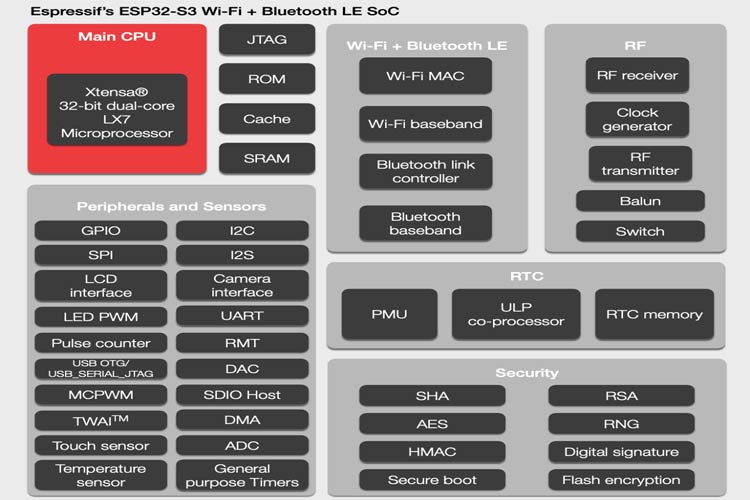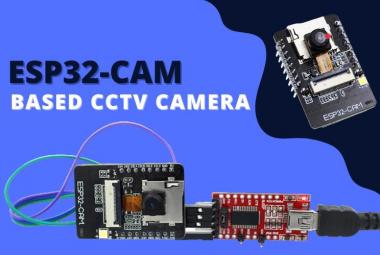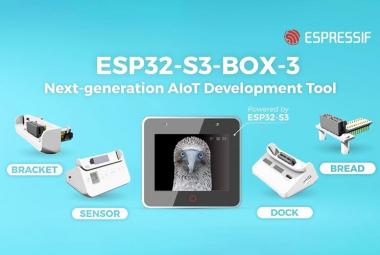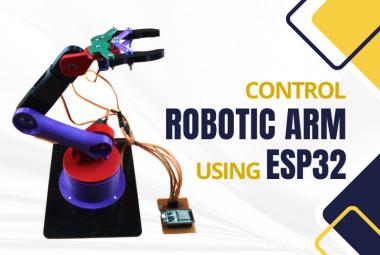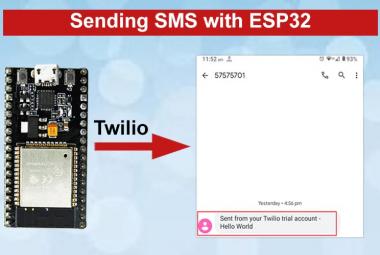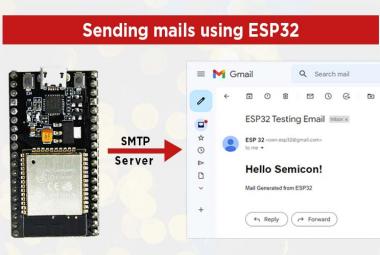Addressing the rising needs of the AIoT (AI + IoT) market, ESP32-S3 from Espressif is a dual-core XTensa LX7 MCU that comes with 2.4 GHz WiFi 4 and Bluetooth 5 connectivity, expanded GPIO, AI-focused instructions, hardware-accelerated security features. Compared to its previous version of ESP32, this new MCU supports larger, high-speed octal SPI flash, and PSRAM with configurable data and instruction cache.
The device has 512 KB of internal SRAM and its Wi-Fi and Bluetooth-Low-Energy 5.0 connectivity provides long-range support. It has 44 programmable GPIOs and supports a rich set of peripherals. The vector instructions that provide acceleration for neural networks and signal processing loads make ESP32-S3 best suited for AI applications. Security features with an HMAC controller for message authentication, a Digital Signature (DS) module that provides hardware-accelerated message signing, secure boot capability that verifies the RSA-PSS signature of an application image before executing it are the notable features of the new MCU.
Additional encryption includes "Flash Encryption" for off-chip flash memory. "World Controller" peripheral makes fully-isolated execution environments possible, thereby isolating security-sensitive data tasks from the rest of the application.
Key Features and Specifications of ESP32-S3
- CPU: Dual-core Tensilica LX7 up to 240 MHz with additional vector instructions for AI acceleration and ULP core to handle low power modes
- Memory: 512 KB of internal SRAM
- Storage: Octal SPI flash and PSRAM support (supports larger, high-speed devices compared to ESP32)
- Wi-Fi + Bluetooth LE 5.0 Wireless Connectivity: 2.4 GHz 802.11 b/g/n Wi-Fi 4 with 40 MHz bandwidth support and Bluetooth Low Energy (BLE) 5.0 connectivity with long-range support, up to 2Mbps data rate.
- Rich set of IO Peripherals: 44x programmable GPIOs (10 more than ESP32), SD/MMC host, SPI, I2C, PWM, UART, RMT (Remote Control), TWAI (Two-Wire Automotive Interface), ADC, DAC, I2S, USB OTG, Capacitive touch input, ULP (Ultra-Low-Power) core that supports multiple low-power modes in a variety of such use-cases.
- Security: AES-XTS-based flash encryption, RSA-based secure boot, digital signature peripheral, and an HMAC module (similar to a secure element), “World Controller” peripheral that provides two fully-isolated execution environments and enables a trusted-execution environment or a privilege-separation scheme.
- AI Acceleration Support: Additional support for vector instructions in the MCU, which provides acceleration for neural network computing and signal processing workloads. The software libraries for the above-mentioned optimized functions will become available very soon, in the form of updates to ESP-WHO and ESP-Skainet.
- Mature Software Support: Supported by Espressif’s popular ESP-IDF platform that already powers millions of devices on the market. ESP-IDF comes with rigorous testing, regular updates, and an unparalleled support policy. Based on ESP-IDF’s mature software architecture, developers can easily build applications anew or migrate their own applications to the ESP32-S3 platform and continue working with the trusted ESP-IDF tools and APIs.
The new ESP32-S3 stands out in terms of connectivity, AI computing power, security, IO availability, and peripheral interfaces. The MCU will provide device manufacturers and developers with a cost-effective and easy-to-develop AIoT solution platform, for an enhanced experience of smart networking.






